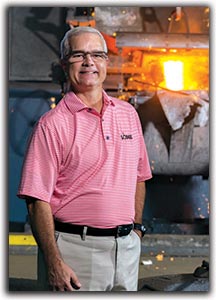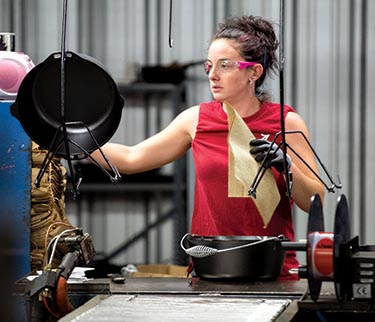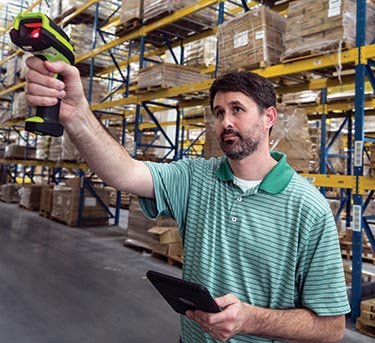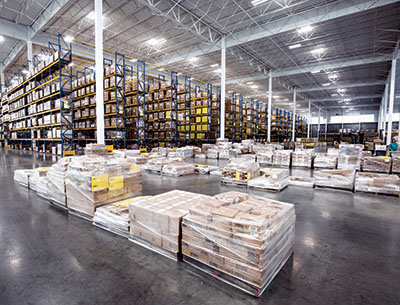Lodge Manufacturing: Distribution Cast in Iron
In a new facility, iPhones and a new WMS allowed cookware manufacturer Lodge to double its business for the fourth time in 20 years and shorten order delivery time from 10 days to three.
What do you do if you’re the century-old manufacturer of an iconic but staid American brand only to find your business is growing so fast that you want to avoid jumping from the fire into the frying pan?
OK, maybe that’s a bad play on words, especially if the manufacturer produces cast iron cookware, but that was the situation confronting Tennessee-based Lodge Manufacturing Company, a 121-year-old, family-owned company that is one of the only brands of cast iron cookware in the United States and whose cast iron skillets were ranked highest by America’s Test Kitchen.
 “Since 1996, our sales doubled, then doubled again and, at the current pace, will double a third time in a few years,” says Sam Touchstone, senior vice president of finance and administration, and an executive with a background in warehousing and distribution. “For several years, we were growing so fast we had to turn away new customers because we couldn’t meet demand.”
“Since 1996, our sales doubled, then doubled again and, at the current pace, will double a third time in a few years,” says Sam Touchstone, senior vice president of finance and administration, and an executive with a background in warehousing and distribution. “For several years, we were growing so fast we had to turn away new customers because we couldn’t meet demand.”
Click here for a detailed overview of the new systems in place at Lodge Manufacturing
The solution to that dilemma was two-fold: The first was to invest $90 million to expand manufacturing and distribution capacity. A new foundry was added when the earlier addition of an extra production line in the existing foundry proved insufficient. In 2015, a new 212,000-square-foot distribution center went up in New Hope, located a few miles from the foundry.
The materials handling processes are conventional, given the weight of cast iron cookware. Pallets are moved by lift and turrets trucks and stored in pallet racks, with the exception of a small area set aside for piece picking to fill the company’s entry into e-commerce. Orders are picked to pallet or built in a drop zone dedicated to building mixed pallets when a number of customers place orders for the same SKUs.
The innovation that has made all the difference is a Cloud-based warehouse management system (WMS; EVS) that brings a number of capabilities to the table:
In the Cloud: As noted above, the WMS is Cloud-based. “The ability to update the WMS on the fly was a huge advantage to us,” says Touchstone. He also notes that the WMS was designed to integrate with their Sage enterprise resource planning (ERP) system.
iOS native: The WMS is built on the Apple operating system. That allows Lodge to use iPhones as mobile computers—and take advantage of familiar features like FaceTime for communication and troubleshooting—and Bluetooth scanners.
Incorporates artificial intelligence (AI) and warehouse simulation: The solution can simulate warehouse operations under multiple sce¬narios and provide comparative efficiency metrics.
“We didn’t have a WMS in our old facility,” says Touchstone. “We manually printed out pick tickets and labels, and had no metrics to measure how we were doing.”
Since going live last June, the company began using the WMS to measure on-time shipping, which has improved significantly,” says Touchstone. “And, we have the capabilities that will allow us to expand our e-commerce business, move toward next-day deliveries and develop drop shipment capabilities for our brick-and-mortar retail customers.”
Think of it as a distribution strategy cast in iron.

Keeping up with demand
“Since 1896, Lodge has been making the cookware you love…We don’t just make iron; we make heirlooms that bring people together for generations.”
So reads the greeting on Lodge Manufacturing’s Website. The company was founded as the Blacklock Foundry by Joseph Lodge in the hamlet of South Pittsburg, Tenn., about 40 minutes west of Chattanooga. After a fire in 1910, a new foundry was built near the original and the company was re-named Lodge Manufacturing Company.
Innovation and automation have been core to the company since the 1950s, when the foundry was converted from a hand-pour to automated molding process to keep up with demand. In 1992, Lodge replaced its coke-fired cupola furnaces with an electro-magnetic induction melting system that earned a Tennessee Governor’s Award for Excellence in Hazardous Waste Reduction. And, in 2002, a line of pre-seasoned cast iron cookware was introduced, eliminating the hassle of its unseasoned counterparts. An industry first, pre-seasoning has since become an industry standard.
Today, Lodge remains a family-owned business dedicated to manufacturing in America. “Our place in the market is that we’re one of the only brands of cast iron cookware in the United States and will continue to be in the future,” Touchstone notes. With roots in small-town Tennessee, the company is also committed to its employees’ quality of life—10% of pre-tax profits are distributed every quarter to employees who have been with the company for a certain period of time and another 10% is contributed annually to the employee deferred profit sharing plan (20% in total). At one point, management decided to cut back on sales so staff didn’t have to work in the foundry on Fridays and some Saturdays after four 10-hour days from Monday to Thursday to keep up with demand. “Leadership wanted our employees to have a life outside of the business,” says Touchstone.
 Pre-seasoned cookware was a big contributor to the company’s sales in the early 2000s, but so has the exposure cast iron has received from top chefs on popular cooking shows. To keep up with that demand, Lodge added an extra production line to its foundry several years ago. “We thought it would accommodate our growth for the next 10 years, and it didn’t,” says Touchstone. “We still had to turn away customers because we couldn’t meet demand.” That led to a $90 million investment in a new foundry and a new distribution center.
Pre-seasoned cookware was a big contributor to the company’s sales in the early 2000s, but so has the exposure cast iron has received from top chefs on popular cooking shows. To keep up with that demand, Lodge added an extra production line to its foundry several years ago. “We thought it would accommodate our growth for the next 10 years, and it didn’t,” says Touchstone. “We still had to turn away customers because we couldn’t meet demand.” That led to a $90 million investment in a new foundry and a new distribution center.
The genesis for the new DC was driven not just by the growth of the business but also by the changing nature of the business. Lodge’s products are sold across a variety of channels and demographics. Its customer base includes big box retailers like Target and Walmart, hardware stores like ACE/True Value, Cracker Barrel gift shops, specialty retailers like Williams Sonoma, and mom-and-pop kitchen and gift shops.
The product line includes about 140 items, extending from traditional cast iron skillets to a 9-inch mini-wok designed for individuals living in small apartments. However, given the bulk and weight of cast iron and the fight for shelf space, retailers often only stock and display a handful of products.
“We want our brick-and-mortar customers to provide access to our entire product line, which means they’re putting them on their Websites,” says Touchstone. “That’s forcing us to be able to fill that demand.”
Last, but certainly not least, customers want faster order turnaround times than Lodge had been able to provide using its old system. The need for more production capacity was part of the problem—it was not uncommon for the foundry to manufacture to fill an order rather than to create back stock. But part of the issue was also an antiquated manual distribution system.

In the DC, newly received pallets are putaway for storage (left). An associate scans a packages before picking (center). In the drop zone, associates build mixed pallets for shipment (right).
“Our old DC was only 40,000 square feet and the ERP system looked at the warehouse as one bin location,” Touchstone recalls. When product was received from the foundry, associates did their best to store the same SKUs in the same spot every time so they’d know where to find it when they go to pick an order. Not having a WMS, or bar code scanning, meant the ERP was managing orders. But, it couldn’t capture weight and dimension information, which shipping needed to route orders. It often showed negative inventory on hand. To make matters worse, there was no standardization as to what constituted a full pallet coming over from the foundry: Some pallets might have 100 units while others might only have 98.
“We were manually creating labels, manually stretch wrapping, and since we didn’t have an accurate inventory, we would do a manual count to make sure we had all the product for big orders,” Touchstone says. Getting product out the door was delayed because shipping couldn’t route an order until it was manually picked, wrapped, weighed and then an associate reported the information. On average, there were 10 days between receiving an order and getting it out the door.
It was clearly time for more distribution capacity and a new, more automated processes.
Bring in WMS
The new 212,000-square-foot facility includes 38 aisles of storage. Twenty-one aisles are dedicated to replenishment and overstock locations. Aisles include seven pallet levels reaching to 33 feet with 62 pallet locations per level, or 434 locations per aisle. Given the weight of cast iron, the facility still uses lift trucks and turret trucks for pallet movement and manual pick to pallet processes. In that regard, the WMS is central to driving efficiencies.
One of the first steps in making all of that happen was a cultural change. The Lodge team was loyal and experienced when it came to shipping out millions of pounds of cast iron without a system; given the lack of tools, they did a great job at that. But they didn’t know how to run a modern DC with WMS and bar coding technology.
While Touchstone came onboard as a financial officer, he had a significant amount of logistics experience, including the layout of warehouses and three prior WMS implementations at previous stops, including a major retailer with a significant e-commerce business. Among his first two decisions was to hire a new DC manager who had previously run a DC for a leading retailer and to bring in a consultant to advise on the WMS implementation.
The WMS project began with four key goals:
- ERP integration: “We’re a Sage ERP house and we wanted a Cloud-based WMS that could integrate with Sage today or another ERP down the road if we change our system,” says Touchstone.
- Reduce order fulfillment times: “Ninety-nine percent of what we ship out is wholesale, so we wanted to get our stock to ship time from 10 days down to four, or, ideally, just three,” says Touchstone.
- Ease of use: Implementing a system that would be easy to use by employees who had no prior experience with a WMS was key.
- Create a foundation for an e-commerce/drop shipment program: “E-commerce is becoming more important to our brick-and-mortar retail customers than ever, and we wanted a system that would allow us to develop drop ship capabili¬ties in the future.” Indeed, while it isn’t fully functional yet, Lodge is in the process of developing a segregated area for piece picking.
The new WMS met all four criteria. For one, it had the capability to integrate with multiple ERP systems; for another, because it is Cloud based, Lodge can update the system easily on the fly. “I’ve had to update server-based ERP systems in the past, where we had to uninstall and re-install the new system on every computer,” says Touchstone. “Cloud allows us to adopt new changes and do it much faster and easier.”
A second big driver was ease of use: Since the WMS is native to Apple’s operating system, the 21 order selectors and lift truck drivers have all been issued iPhones and matched Bluetooth scanners. “The cost of an iPhone and scanner was about $900, which was very affordable compared to a conventional mobile computer and scanner,” Touchstone says. “But just as important is the fact that our employees already know how to use smart phones. We were able to give them something that they’re already familiar with.”
 Indeed, Touchstone says associates were able to fill e-commerce orders on day one and were filling and shipping wholesale orders by day four of the go live.
Indeed, Touchstone says associates were able to fill e-commerce orders on day one and were filling and shipping wholesale orders by day four of the go live.
Among the benefits of using iPhones: Instead of walkie-talkies, associates can communicate over the phones, and, using the camera function, show a supervisor or another associate the problem they’re dealing with. “On day three, one of our younger associates was FaceTime-ing with a supervisor on the phone,” says Touchstone. “In very short order, we had a group that had been working for 10 or 15 years in a manual distribution center working with a WMS.”
And, with robust capabilities, the WMS has led to a significant reduction in order fulfillment times. “In our old system, the office printed a pick list and the UCC labels. After an order was picked, an associate would come back in and say that the order was five pallets and weighed 10,000 pounds. It was only then that we could call routing and arrange for a shipment,” Touchstone says. “Now, the WMS can calculate the number of pallets and weight when an order is received. That allows shipping to arrange for a pick up while the order is being picked and stretch wrapped.”
While e-commerce amounts to only about 100 orders a day at present, Lodge is creating a separate system-directed, piece picking area in the DC to do more drop shipments and next-day deliveries. The facility will use a pick-to-cart picking process, with three conveyor lines feeding pack stations.
“This facility, and the WMS, will allow us to double our business for the fourth time since 1996,” says Touchstone. “And, we now have the capabilities to become a stock to order facility with a three-day delivery time.”













